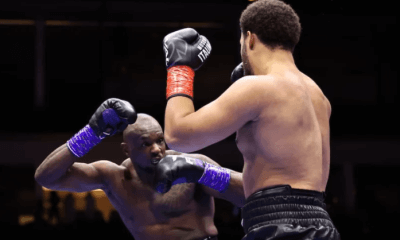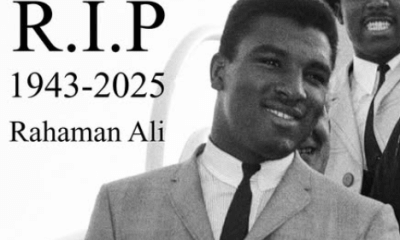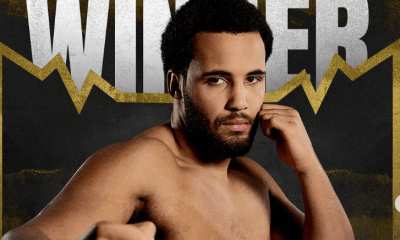Featured Articles
A Conversation With Award-Winning Boxing Writer Lance Pugmire

A masterful storyteller, Lance Pugmire spent nearly two decades covering sports for the Los Angeles Times. He is the most-recent recipient of the prestigious Nat Fleischer Award for Excellence in Boxing Journalism which is presented annually by the Boxing Writers Association of America.
Trustworthy is just one reason why Pugmire has had a successful sports writing career.
“I’d like to think of myself as the type of reporter that the athletes, no matter how high profile they became in their career, they could trust me completely, and that they knew that, yes, I am on the quest for the truth, but I’m also going to allow them to speak their truth while delivering it the way they wanted it delivered,” he said.
Pugmire spoke about the trust Saul “Canelo” Alvarez had in him while Canelo was training for a fight several years ago.
“One time I went to San Diego and Alvarez gave me an interview in English, and I like to think I was the first reporter he spoke to in English,” he said of the boxer who will meet Jermell Charlo on September 30.
Pugmire also built a rapport with Miguel Cotto who had two big matches with Antonio Margarito.
Margarito was accused of using loaded hand-wraps on more than one occasion including his first meeting with Cotto and had his license revoked for one year by the Nevada State Athletic Commission.
“I was able to do a lot of reporting on loaded gloves,” Pugmire noted. “When I spoke to Cotto,” he said to me, “he knows about the hand wraps. I will get revenge for this. When he fought him at Madison Square Garden [December 2011] in front of all his people, that was one of the more emotional fights that I covered.” (After Cotto lost to Margarito in July 2008 in Las Vegas via eleventh-round technical knockout, Cotto came back and earned a ninth-round stoppage in the rematch).
While Pugmire is straightforward in his dealings with the men in the ring, so too are they honest with him.
“I’ve always had a soft spot for them. Boxers are always an open book on every level. It doesn’t matter whether it’s Tyson Fury or some young prospect on his way up,” he pointed out. “There’s not a lot of publicists in their ear saying, ‘don’t talk about this and don’t talk about that.’ They always give you their truth and then you report it as you see fit. As a reporter we like to know that it’s not scripted or sugar coated and that’s what I like about boxers.”
Pugmire began his career in 1999 at the Times Inland Valley office. He covered the 2000 Shane Mosley-Oscar De La Hoya fight as a round-by-round reporter and became a full-time boxing writer in 2007 with the Israel Vasquez-Rafael Marquez tussle.
Pugmire enjoyed his tenure at the Times, but felt a tugging to try something different.
“I absolutely loved my 19 years at the Los Angeles Times – so many amazing experiences and unforgettable stories that we nailed,” he said. “I’ve always sought to continue challenging myself. Because of my earnings there and The Athletic, I was able to experience real estate investment, which led me to a new career that is still all about learning people’s stories and helping them reach a better place. Not ever taking myself out of my comfort zone would have been my ultimate regret.”
To this end, Pugmire recently moved into a career selling high-end property for Seven Gables Real Estate/MX Associates in Huntington Beach after nearly two decades at the Los Angeles Times.
While boxing doesn’t hold sway like it once did, there are weekends when the sport is still important, such as the night Crawford faced Spence at T-Mobile Arena.
“The powers that be who run boxing know that staging these great fights is the best thing for the sport’s future. So, when we can get these fights, everybody knows this is the fight that should be happening,” Pugmire noted. “Then boxing still has the ability to capture the mainstream sports fans and get complete attention on that Saturday fight night. That is still the great thing about boxing. Boxing will never die as long as it is giving fans that moment.”
Crawford-Spence turned out to be lopsided in favor of Crawford who won on a ninth-round stoppage, notes Pugmire, but it still created significant buzz because it did take place after a lot of earlier wrangling.
“When Spence said, ‘Unless you’re going to bring me a Crawford fight, I’m not going to fight,” he [he showed that he] understands what this sport is about…For Spence, he believed I’m the naturally bigger man, I am the more skilled man, and I can win this fight. As tough as Crawford is and an undefeated three-division champion, we all know Terence is one of the great finishers of this generation. For Spence to take on this fight, he has to be given a lot of credit.”
Boxing will always have a place in the sun even if it’s not at the top of the food chain.
“To me, there’s no better example, so let’s just go global,” Pugmire said. “Manny Pacquiao sold rice on the streets so he and his family could eat. If it wasn’t for boxing, what would have become of Pacquiao? This is someone who, with his money, with his power, is elevated to political office and is doing everything that he can to help his fellow humans in the Philippines escape the ravages of poverty. We all know this [boxing] isn’t good for someone’s health. Absolutely not.”
Pugmire was able to cozy up to Pacquiao and Floyd Mayweather Jr., who were two very opposite personalities.
“The creativity and the power that we saw from Pacquiao as he moved through these divisions was such an impressive thing to cover. Same thing with Mayweather. His defensive acumen and his brilliance of being able to figure out whatever opponent was set before him. Even if it was to his advantage to handpick guys like a 23-year-old Alvarez or an over-the-hill Oscar De La Hoya,” he said. “The fact is that he did it. [We all who covered Floyd’s career] know that there were many tough fights against guys like Jose Luis Castillo that he took that were 50-50 endeavors, and even his fight against Marcos Maidana, that was a tough task. He found a way to get the victory. He fought Cotto and Juan Manuel Marquez. The guy deserves to be credited. In my eyes, it’s not a sin how he handled his career.”
The May 2015 bout between Pacquiao and Mayweather was a dud in terms of entertainment, but an immense money-maker.
Pugmire recalls being inside the MGM Grand Garden Arena that evening.
“To me, when I see these two guys, I always go back to that moment when I looked up right before the first bell rang and they were both bouncing in each other’s corner right before it went down,” he recalled. “Wow, it was one of the most electric moments that I can ever remember.”
Pugmire no longer covers boxing full-time but still keeps track of the sport. As a contributor to the boxing website ppv.com, he covered the Gervonta Davis-Ryan Garcia battle and the Terence Crawford-Errol Spence Jr. showdown.
He’s honored that the Boxing Writers Association of America deemed his block of work worthy of being included with the best writers to have spent time ringside.
“The thing that really struck me after looking at the past winners was who had won the Fleischer before me and how deeply I’ve been influenced by past winners,” he said. “Growing up in Phoenix, I read Norm Frauenheim in grade school. When I moved to Orange County to go to college [majoring in communications with an emphasis in journalism] at Cal State Fullerton, I read Mark Whicker. My sports editor at the Los Angeles Times that brought me downtown from a satellite office in Ontario was Bill Dwyer. I’m very close to Dan Rafael.”
Pugmire then spoke about the obligation all reporters have.
“These guys were never beholden to any particular side. They were not shills. They spoke their truth. They were obligated to the readers,” he said. “I was there to tell the truth and I do love the sport and I was there to communicate what their stories were in the most truthful, elegant and dignified way that I could. That enough people on this committee noticed my work is a great honor. They said, ‘You belong among us.’”
And now he does.
To comment on this story in the Fight Forum CLICK HERE
-

 Featured Articles3 weeks ago
Featured Articles3 weeks agoThe Hauser Report: Zayas-Garcia, Pacquiao, Usyk, and the NYSAC
-

 Featured Articles3 weeks ago
Featured Articles3 weeks agoOscar Duarte and Regis Prograis Prevail on an Action-Packed Fight Card in Chicago
-

 Featured Articles2 weeks ago
Featured Articles2 weeks agoThe Hauser Report: Cinematic and Literary Notes
-

 Book Review1 week ago
Book Review1 week agoMark Kriegel’s New Book About Mike Tyson is a Must-Read
-

 Featured Articles3 weeks ago
Featured Articles3 weeks agoRemembering Dwight Muhammad Qawi (1953-2025) and his Triumphant Return to Prison
-

 Featured Articles4 days ago
Featured Articles4 days agoMoses Itauma Continues his Rapid Rise; Steamrolls Dillian Whyte in Riyadh
-

 Featured Articles2 weeks ago
Featured Articles2 weeks agoRahaman Ali (1943-2025)
-

 Featured Articles2 weeks ago
Featured Articles2 weeks agoTop Rank Boxing is in Limbo, but that Hasn’t Benched Robert Garcia’s Up-and-Comers


















